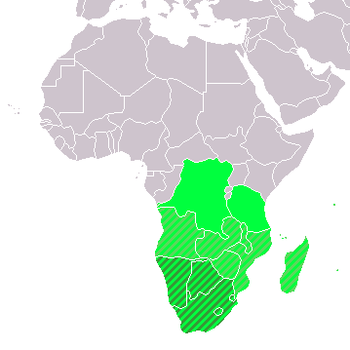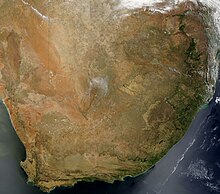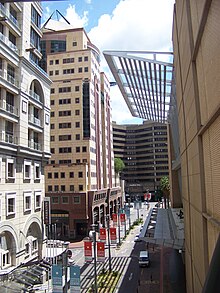Southern Africa
The article's lead section may need to be rewritten. (May 2022) |


Southern Africa is the southernmost region of Africa. No definition is agreed upon, but some groupings include the United Nations geoscheme, the intergovernmental Southern African Development Community, and the physical geography definition based on the physical characteristics of the land.
Defined by physical geography, Southern Africa is home to a number of river systems; the Zambezi River is the most prominent. The Zambezi flows from the northwest corner of Zambia and western Angola to the Indian Ocean on the coast of Mozambique. Along the way, it flows over Victoria Falls on the border between Zambia and Zimbabwe. Victoria Falls is one of the largest waterfalls in the world and a major tourist attraction for the region.[1]
Southern Africa includes both subtropical and temperate climates, with the Tropic of Capricorn running through the middle of the region, dividing it into its subtropical and temperate halves. Countries commonly included in Southern Africa include Angola, Botswana, the Comoros, Eswatini, Lesotho, Madagascar, Malawi, Mauritius, Mozambique, Namibia, South Africa, Zambia, and Zimbabwe. In cultural geography, the island country of Madagascar is often not included due to its distinct language and cultural heritage.[1]
Definitions and usage
In physical geography, the geographical delineation for the subregion is the portion of Africa south of the Cunene and Zambezi Rivers: Botswana, Eswatini, Lesotho, Namibia, South Africa, Zimbabwe, and the part of Mozambique that lies south of the Zambezi River. That definition is most often used in South Africa for natural sciences and particularly in guidebooks such as Roberts' Birds of Southern Africa, the Southern African Bird Atlas Project, and Mammals of the Southern African Subregion. It is not used in political, economic, or human geography contexts because the definition cuts Mozambique in two.[citation needed]
UN scheme of geographic regions and the SACU
In the United Nations geoscheme for Africa, five states constitute Southern Africa:[2]
 Botswana
Botswana Eswatini (Swaziland)
Eswatini (Swaziland) Lesotho
Lesotho Namibia
Namibia South Africa
South Africa
This definition includes the Comoros, Madagascar, Malawi, Mauritius, Mayotte, Mozambique, Réunion, the Scattered Islands in the Indian Ocean (as a part of the French Southern Territories), Zambia, and Zimbabwe in Eastern Africa, Angola in Middle Africa (or Central Africa), and Saint Helena, Ascension, and Tristan da Cunha (under the name Saint Helena) in Western Africa, instead. Some atlases include Malawi, Zambia, and Zimbabwe in Central Africa instead of Southern or Eastern Africa.
The Southern African Customs Union, created in 1969, also comprises the five states in the UN subregion of Southern Africa.[3]
SADC membership
The Southern African Development Community (SADC) was established in 1980 to facilitate co-operation in the region. It includes:[4]
 Angola
Angola Botswana
Botswana Comoros
Comoros Democratic Republic of the Congo
Democratic Republic of the Congo Eswatini (Swaziland)
Eswatini (Swaziland) Lesotho
Lesotho Madagascar
Madagascar Malawi
Malawi Mauritius
Mauritius Mozambique
Mozambique Namibia
Namibia Seychelles
Seychelles South Africa
South Africa Tanzania
Tanzania Zambia
Zambia Zimbabwe
Zimbabwe
General usage
Other than the UN subregion, these countries and territories are often included in Southern Africa:[citation needed]
The Democratic Republic of the Congo is generally included in Central Africa, while Seychelles and Tanzania are more commonly associated with Eastern Africa, but these three countries have occasionally been included in Southern Africa, as they are the SADC members.
Geography


The terrain of Southern Africa is varied, ranging from forest[5] and grasslands to deserts. The region has both low-lying coastal areas, and mountains.
In terms of natural resources, the region has the world's largest resources of
Southern Africa is set apart from other Sub-Saharan African regions because of its mineral resources, including copper, diamonds, gold, zinc, chromium, platinum, manganese, iron ore, and coal. Countries in Southern Africa are larger in geographic area, except three smaller landlocked states: Lesotho, Swaziland, and Malawi. The larger states- South Africa, Botswana, Mozambique, Zimbabwe, Zambia, Namibia, and Angola—all have extensive mineral deposits.[7]
These widespread mineral resources make this one of the wealthiest regions of Africa with the greatest potential for
Climate
The climate of the region is broadly divided into subtropical in the north and temperate in the south, but also includes humid-subtropical, Mediterranean-climate, highland-subtropical, oceanic, desert, and semi-arid regions. Except for lower parts of Zambia and interior areas of Namibia and Botswana, the region rarely suffers from extreme heat. In addition, the winter presents mostly as mild and dry, except in the southwest. Cool southeasterly winds and high humidity bring cool conditions in the winter. The Namib Desert is the driest area in the region.
. There are high temperatures and low rainfall within the Zambezi and Limpopo river valleys, probably due to the lower altitude.The
Across most of southern Africa, apart from the Western Cape in South Africa, the major rainfall season is during the southern-hemisphere summer, from December to February. In the Western Cape, the rainfall maximum occurs from June through August.
There are a number of important rainfall-producing weather systems in southern Africa. These include tropical-extra-tropical cloud bands, tropical lows, and
Year-to-year variability in rainfall, including drought, is associated with changes in global and regional
Future climate projections suggest that much of southern Africa will get hotter and drier in response to global climate change.
History
Prehistory
East and southern Africa are among the earliest regions where modern humans (Homo sapiens) and their predecessors are believed to have lived. In September 2019, scientists reported the computerized determination, based on 260
Kingdom of Mapungubwe
The Kingdom of Mapungubwe (c. 1075–c. 1220) was one of the earliest state in the South African region. It was located at between the Shashe and Limpopo Rivers. The name is derived from either TjiKalanga and Tshivenda. The kingdom is thought to have existed as the first class-based social system within the region. Society was mainly centered around family and farming. The kingdom would culminate to the Kingdom of Zimbabwe in the 13th century. And at its height the capital's population was about 5000 people.[12] There are no written records from the kingdom and what historians and archeologists know of the state is from the remains of buildings.
Kingdom of Zimbabwe and successor states
The
Mthethwa Paramountcy
The
Zulu Kingdom
The Zulu Kingdom rose under the leadership of Shaka and covered most of present-day KwaZulu-Natal in the 19th century. Internal conflict arose in the 1820s between Shaka's half-brothers Dingane and Mhlangana due to a succession dispute. Boer settlers began arriving northwards of the Orange River in the 1830s,[15] which led to conflicts between the two peoples and resulted in the Battle of Blood River in 1838. The kingdom fell during the Anglo-Zulu War of the late 19th-century.
Post-colonial eras
In the aftermath of
Economy

The region is distinct from the rest of Africa, with a robust mining sector and comparatively developed secondary and
, Southern Africa still faces some of the problems that the rest of the continent does. Despite this, diamond production has fueled the economies of Botswana and Namibia, for example.Over the 20th century, the region developed a robust manufacturing sector, focused on South Africa and Zimbabwe, which allowed greater prosperity and investments into infrastructure, education and healthcare that elevated both nations into middle income economies and captured growing markets across Africa.[16] However, since the 1990s these industries have struggled in the face of globalization and cheaper imports from China, leading to job losses particularly in heavy industry, gold mining and textiles. Zimbabwe in particular has seen significant deindustrialization as a result of factors both domestic and foreign.[17] While colonialism has left its mark on the development over the course of history,[18][19] today poverty, corruption, and HIV/AIDS are some of the biggest factors impeding economic growth. In addition, South Africa and Zimbabwe in particular, face high emigration among their skilled workers leading to a significant brain drain to western economies and billions lost in human capital flight. The pursuit of economic and political stability is an important part of the region's goals, as demonstrated by the SADC, however complete regional integration remains an elusive target.
In terms of economic strength, South Africa is the dominant economy of the region. Generally, mining, agriculture, the
Environment
Southern Africa has a wide diversity of ecoregions including
. It has complex Plateaus that create massive mountain structures along the South African border.There are numerous environmental issues in Southern Africa, including air pollution and desertification.
Culture
Art
Architecture
Clothing
Cuisine
Music
Religion
Film industry
Demographics and languages
Southern Africa is home to many people. It was initially populated by
Architecture
Further information in the sections of Architecture of Africa:
Science and technology
Further information in the sections of History of science and technology in Africa:
Agriculture and food security
Some key factors affecting the food security within the regions including political instability, poor governance, droughts, population growth, urbanisation, poverty, low economic growth, inadequate agricultural policies, trade terms and regimes, resource degradation and the recent increase in HIV/AIDS.[23][24]
These factors vary from country to country. For example, the Democratic Republic of the Congo has favourable climatic and physical conditions, but performs far below its capacity in food provision due to political instability and poor governance. In contrast, semi-arid countries such as Botswana and Namibia, produce insufficient food, but successfully achieve food security through food imports due to economic growth, political stability and good governance. The Republic of South Africa is a major food producer and exporter in the region.[25]
Data on agricultural production trends and food insecurity especially in term of food availability for Southern Africa is readily available through the Famine Early Warning Systems Network (FEWS NET) and Southern African Development Community (SADC) - Food, Agriculture and Nature Resource Directorate (FARN). However, this data might not fully capture the reality of a region with large urban populations and where food insecurity goes beyond per-capita availability to issues of access and dietary adequacy.[26][27]
Urban food security has been noted as an emerging area of concern in the region, with recent data showing high levels of food insecurity amongst low-income households. In a study of eleven cities in nine countries:
Some factors affecting urban food insecurity include climate change with potential impact on agricultural productivity, the expansion of supermarkets in the region, which is changing the way people obtain food in the city, rural-to-urban migration, unemployment, and poverty.[29][30][31][32] The issue of food insecurity in general and urban food insecurity in particular in the region is also characterized by an increased consumption of caloric junk food and processed foods leading to potential increase in the co-existence of undernutrition and dietary-related chronic diseases such as obesity and hypertension.[33][34] In South Africa for example, while over 50% experience hunger, 61% are overweight or morbidly obese.[35][36][37] There is only limited data on the other Southern African countries.
From 2018 to 2021, parts of the region suffered from a period of drought.[38]
See also
- Central Africa
- East Africa
- Kalahari Desert
- Maghreb
- North Africa
- Northeast Africa
- Southeast Africa
- Sub-Saharan Africa
- West Africa
References
- ^ a b "Southern Africa".
- ^ "Composition of macro geographical (continental) regions, geographical subregions, and selected economic and other groupings".
- ^ "Southern African Customs Union (SACU) official website". Archived from the original on 2011-05-03. Retrieved 2022-03-03.
- ^ "Southern African Development Community :: Home". www.sadc.int.
- ISBN 978-0-521-54801-4.
- ^ SADC. "Mining". Retrieved 27 June 2013.
- ^ "A visual journey across African landscapes". Landscape News. 2019-10-22. Retrieved 2021-05-30.
- ^ "Southern African Landscapes and Environmental Change". Routledge & CRC Press. Retrieved 2021-05-30.
- ^ a b "Africa: Physical Geography". National Geographic Society. 2012-01-04. Retrieved 2021-05-30.
- ^ Zimmer, Carl (10 September 2019). "Scientists Find the Skull of Humanity's Ancestor — on a Computer - By comparing fossils and CT scans, researchers say they have reconstructed the skull of the last common forebear of modern humans". The New York Times. Retrieved 10 September 2019.
- PMID 31506422.
- ^ Huffman, page 376
- ISBN 978-0-203-48386-2.
- ^ Longman History of Southern Africa, Longman Publishing, 1978
- ^ Meredith, Martin (2007). Diamonds Gold and War. New York: Public Affairs. p. 5.
- ^ "Archived copy" (PDF). Archived from the original (PDF) on 2021-05-12. Retrieved 2021-03-19.
{{cite web}}: CS1 maint: archived copy as title (link) - SSRN 2929593.
- ISBN 90-420-1229-3.
- ISBN 1-58826-332-0.
- ^ Hauge, Jostein (2019-08-20). "Should the African lion learn from the Asian tigers? A comparison of FDI-oriented industrial policy in Ethiopia, South Korea and Taiwan". Developing Economics. Retrieved 2021-05-30.
- ^ Bauer, H.; Packer, C.; Funston, P.F.; Henschel, P.; Nowell, K. (2016). "Panthera leo". IUCN Red List of Threatened Species. 2016: e.T15951A107265605. Retrieved 8 August 2023.
- ^ Goeieman, Fred (November 30, 2011). "Bridging a hundred year-old separation". Namibian Sun. Archived from the original on October 29, 2013. Retrieved 2013-05-23.
- S2CID 562611.
- .
- ^ Yu, Bingxin; Liangzhi You; Shenggen Fan (January 2010). "Toward a Typology of Food Security in Developing Countries" (PDF). International Food Policy Research Institute. Retrieved 29 June 2013.
- ^ FEWS, NET. "Southern Africa Country Centers". Retrieved 29 June 2013.
- ^ SADC, FANR. "Food Security". Retrieved 29 June 2013.
- ]
- S2CID 55452849.
- S2CID 55778001.
- S2CID 154319323.
- S2CID 13382935.
- ISBN 978-1-920409-69-2.
- S2CID 206007700.
- ^ Fat in Motion. "Obesity in SA". Retrieved 29 June 2013.
- PMID 18547451.
- ^ LABADARIOS, Demetre; Yul Derek DAVIDS; Zandile MCHIZA; Gina WEIR-SMITH (31 March 2009). "THE ASSESSMENT OF FOOD INSECURITY IN SOUTH AFRICA" (PDF). Human Sciences Research Council. Retrieved 29 June 2013.
- ^ "Hunger in Africa continues to rise, says New UN report". East African Business Week. 2019-02-14. Retrieved 2019-02-15.
Further reading
- "Southern Africa". Encyclopædia Britannica. Retrieved 2013-05-20. (subscription required)
